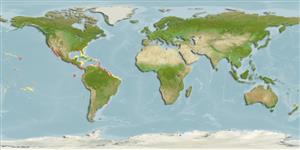Common names from other countries
Classification / Names / Names
Nomi Comuni | Sinonimi | Catalog of Fishes (gen., sp.) | ITIS | CoL | WoRMS
Environment: milieu / climate zone / depth range / distribution range
Ecologia
; distribuzione batimetrica 0 - 27 m (Ref. 865). Tropical
Eastern Pacific and Western Atlantic: Caribbean.
Length at first maturity / Size / Peso / Age
Maturity: Lm ? range ? - ? cm Max length : 30.0 cm WD maschio/sesso non determinato; (Ref. 865)
This is an epibenthic echinoderm (Ref. 83942).
Life cycle and mating behavior
Maturità | Riproduzione | Deposizione | Uova | Fecundity | Larve
Members of the class Ophiuroidea are mostly gonochoric, others are protandric. Fertilization is external. Brooding is common, bursae is used as brood chambers where the embryos develop into juveniles and later crawl out from the bursal slits. Life cycle: Embryos hatch into free-swimming planktotrophic larvae and later metamorphose into tiny brittle stars which sink down the bottom where they grow into adult form.
Alvarado, J.J. and J. Cortés. 2009. (Ref. 83942)
IUCN Red List Status (Ref. 130435)
CITES status (Ref. 108899)
Not Evaluated
Not Evaluated
Human uses
| FishSource |
Strumenti
Informazioni ulteriori
Age/Size
Accrescimento
Length-weight
Length-length
Morfologia
Larve
Abbondanza
Fonti Internet
Estimates based on models
Preferred temperature
(Ref.
115969): 18.5 - 28.5, mean 25.6 (based on 700 cells).
Price category
Unknown.
